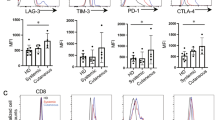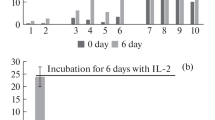Abstract
In early stages of cutaneous T cell lymphoma (Sézary syndrome) both CD4+CD7− and CD4+CD7+ T cells clonally expand whereas in late stages of the disease CD7− cells are predominant in number, giving rise to the question whether CD7− T cells have a survival advantage in the skin. Galectin-1, a cell-bound lectin, was recently reported to trigger apoptosis in activated CD7+ T cells. Here, we demonstrate that in contrast to activated CD7+ T cells, quiescent and activated CD69+ CD7− T cells from healthy donors and from Sézary patients are resistant to galectin-1-mediated cell death. CD7− T cells are apoptosis-resistant even during coculture with IFN-γ-stimulated endothelial cells that constitutively express galectin-1 in high amounts. These data imply that resistance of CD7− T cells to galectin-1-induced apoptosis may contribute to the accumulation of CD7− Sézary T cells during progression of the disease.

Similar content being viewed by others
References
Willemze R, Sterry W, Berti E, Cerroni L, Chimenti S, Diaz-Pérez JL, Geerts ML, Goos M, Knobler R, Ralfkiaer E, Santucci M, Smith N, Wechsler J, van Vloten WA, Meijer CJ . EORTC classification for primary cutaneous lymphoma: a proposal from the cutaneous study group of the European organisation for research and treatment of cancer Blood 1997 90: 354–371
Diamandidou E, Cohen PR, Kurzrock R . Mycosis fungoides and Sezary syndrome Blood 1996 88: 2385–2409
Reinhold U, Abken H . CD4+CD7− T cells: a separate subpopulation of memory T cells? J Clin Immunol 1997 17: 265–271
Bogen SA, Pelley D, Charif M, McCusher M, Koh H, Foss F, Garifallou M, Arkin C, Zucker-Franklin D . Immunophenotypic identification of Sezary cells in peripheral blood Am J Clin Pathol 1996 106: 739–748
Harmon CB, Witzig TE, Katzmann JA, Pittelkow MR . Detection of circulating T cells with CD4+CD7− immunophenotype in patients with benign and malignant lymphoproliferative dermatoses J Am Acad Dermatol 1996 35: 404–410
Rappl G, Muche JM, Abken H, Sterry W, Tilgen W, Ugurel S, Reinhold U . CD4+CD7− T cells compose the dominant T cell clone in the peripheral blood of patients with Sézary syndrome J Am Acad Dermatol 2001 44: 456–461
Nowell PC, Moore JS . Aberrant responses of human lymphocytic neoplasms to cytokine regulation Immunol Res 1998 17: 171–177
Solary E, Droin N, Bettaieb A, Corcos L, Dimanche-Boitrel MT, Garrido C . Positive and negative regulation of apoptotic pathways by cytotoxic agents in hematological malignancies Leukemia 2000 14: 1833–1849
Dereure O, Portales P, Clot J, Guilhou JJ . Decreased expression of Fas (APO-1/CD95) on peripheral blood CD4+ T lymphocytes in cutaneous T-cell lymphomas Br J Dermatol 2000 143: 1205–1210
Dummer R, Michie S, Kell D, Gould JW, Haeffner AC, Smoller BR, Warnke RA, Wood GS . Expression of BCL-2 protein and Ki-67 nuclear proliferation antigen in benign and malignant cutaneous infiltrates J Cutan Pathol 1995 22: 11–17
Osella-Abate S, Zaccagna A, Savoia P, Quaglino P, Salomone B, Bernengo MG . Expression of apoptosis markers on peripheral blood lymphocytes from patients with cutaneous T-cell lymphoma during extracorporeal photochemotherapy J Am Acad Dermatol 2001 44: 40–47
Garatti SA, Roscetti E, Trecca D, Fracchiolla NS, Neri A, Berti E . bcl-1, bcl-2, p53, c-myc, and lyt-10 analysis in cutaneous lymphomas Rec Res Cancer Res 1995 139: 249–261
Kamarashev J, Burg G, Kempf W, Hess Schmid M, Dummer R . Comparative analysis of histological and immunohistological features in mycosis fungoides and Sézary syndrome J Cutan Pathol 1998 25: 407–412
Dobbeling U, Dummer R, Laine E, Potoczna N, Qin JZ, Burg G . interleukin-15 is an autocrine/paracrine viability factor for cutaneous T-cell lymphoma cells Blood 1998 92: 252–258
Rappl G, Abken H, Hasselmann DO, Tilgen W, Ugurel S, Reinhold U . The CD7− subset of CD4+ memory T cells is prone to accelerated apoptosis that is prevented by interleukin-15 (IL-15) Cell Death Differ 2001 8: 395–402
Marincola FM, Jaffeee EM, Hicklin DJ, Ferrone S . Escape of solid human tumors from T-cell recognition: molecular mechanisms and functional significance Adv Immunol 2000 74: 181–273
Muschen M, Warskulat U, Beckmann MW . Defining CD95 as a tumor suppressor gene J Mol Med 2000 78: 312–325
Pace KE, Hahn HP, Pang M, Nguyen JT, Baum LG . CD7 delivers a pro-apoptotic signal during galectin-1-induced T cell death J Immunol 2000 165: 2331–2334
Perillo NL, Pace KE, Seilhamer JJ, Baum LG . Apoptosis of T cells mediated by galectin-1 Nature 1995 378: 736–739
Pace KE, Baum LG . Induction of T lymphocyte apoptosis: a novel function for galectin-1 Trends Glycosci Glycotechnol 1997 9: 21–29
Gabius HJ . Biological information transfer beyond the genetic code: the sugar code Naturwissenschaften 2000 87: 108–121
Allen HJ, Karakousis C, Piver MS, Gamarra M, Nava H, Forsyth B, Matecki B, Jazayeri A, Sucato D, Kisailus E . Galactoside-binding lectin in human tissues Tumour Biol 1987 8: 218–229
André S, Kojima S, Yamazaki N, Fink C, Kaltner H, Kayser K, Gabius HJ . Galectins-1 and -3 and their ligands in tumor biology J Cancer Res Clin Oncol 1999 125: 461–474
Kaltoft K, Bisballe S, Rasmussen HF, Thestrup-Pedersen K, Thomsen K, Sterry W . A continuous T-cell line from a patient with Sezary syndrome Arch Dermatol Res 1987 279: 293–298
Reinhold U, Abken H, Kukel S, Moll M, Müller R, Oltermann I, Kreysel HW . CD7− T cells represent a subset of normal human blood lymphocytes J Immunol 1993 150: 2081–2089
Gabius HJ . Influence of type of linkage and spacer on the interaction of β-galactoside-binding proteins with immobilized affinity ligands Anal Biochem 1990 189: 91–94
Gabius HJ, Engelhardt R, Rehm S, Cramer F . Biochemical characterization of endogenous carbohydrate-binding proteins from spontaneous murine rhabdomyosarcoma, mammary adenocarcinoma, and ovarian teratoma J Natl Cancer Inst 1984 73: 1349–1357
Sacchettini JC, Baum LG, Brewer CF . Multivalent protein-carbohydrate interactions. A new paradigm for supermolecular assembly and signal transduction Biochemistry 2001 40: 3009–3015
Pace KE, Lee C, Stewart PL, Baum LG . Restricted receptor segregation into membrane microdomains occurs on human T cells during apoptosis induced by galectin-1 J Immunol 1999 163: 3801–3811
Rabinovich GA, Iglesias MM, Modesti NM, Castagna LF, Wolfenstein-Todel C, Riera CM, Sotomayor CE . Activated rat macrophages produce a galectin-1-like protein that induces apoptosis of T cells: biochemical and functional characterization J Immunol 1998 160: 4831–4840
Baum LG, Seilhamer JJ, Pang M, Levine WB, Beynon D, Berliner JA . Synthesis of an endogenous lectin, galectin-1, by human endothelial cells is up-regulated by endothelial cell activation Glycoconj J 1995 12: 63–68
Debbage PL, Gabius HJ, Bise K, Marguth F . Cellular glycoconjugates and their potential endogenous receptors in the cerebral microvasculature of man: a glycohistochemical study Eur J Cell Biol 1988 46: 425–434
Lotan R, Belloni PN, Tressler RJ, Lotan D, Xu XC, Nicolson GL . Expression of galectins on microvessel endothelial cells and their involvement in tumour cell adhesion Glycoconj J 1994 11: 462–468
Nguyen JT, Evans DP, Galvan M, Pace KE, Leitenberg D, Bui TN, Baum LG . CD45 modulates galectin-1-induced T cell death: regulation by expression of core 2 O-glycans J Immunol 2001 167: 5697–5707
He YW, Bevan MJ . High level expression of CD43 inhibits T cell receptor/CD3-mediated apoptosis J Exp Med 1999 190: 1903–1908
Mukasa R, Homma T, Ohsuki T, Hosono O, Souta A, Kitamura T, Fukuda M, Watanabe S, Morimoto C . Core 2-containing O-glycans on CD43 are preferentially expressed on the memory subset of human CD4 T cells Int Immunol 1999 11: 259–268
Macon WR, Casey TT, Kinney MC, Collins RD, Cousar JB . Leu-22 (L60). A more sensitive marker than UCHL1 for peripheral T cell lymphomas, particularly large-cell types Am J Clin Pathol 1991 95: 696–701
Gelb AB, Smoller BR, Warnke RA, Picker LJ . Lymphocytes infiltrating primary cutaneous neoplasms selective express the cutaneous lymphocyte-associated antigen (CLA) Am J Pathol 1993 142: 1556–1564
Davis RE, Smoller BR . T lymphocytes expressing HECA-452 epitope are present in cutaneous acute graft-versus-host disease and erythema multiforme, but not in acute graft-versus-host disease in gut organs Am J Pathol 1992 141: 691–698
McCusker ME, Garifallou M, Bogen SA . Sezary lineage cells can be induced to proliferate via CD28-mediated costimulation J Immunol 1997 158: 4984–4991
Rabinovich GA, Alonso CR, Sotomayor CE, Durand S, Bocco JL, Riera CM . Molecular mechanisms implicated in galectin-1-induced apoptosis: activation of the transcription factor and downregulation of bcl-2 Cell Death Differ 2000 8: 747–753
White MK, McCubrey JA . Suppression of apoptosis: role in cell growth and neoplasia Leukemia 2001 15: 1011–1021
Johnson DE . Programmed cell death regulation: basic mechanisms and therapeutic opportunities Leukemia 2000 14: 1340–1344
Fadeel B, Orrenius S, Zhivotovsky B . The most unkindest cut of all: on the multiple roles of mammalian caspases Leukemia 2000 14: 1514–1525
Daniel PT . Dissecting the pathways to death Leukemia 2000 14: 2035–2044
Dummer R, Nestle FO, Niederer E, Ludwig E, Laine E, Grundmann H, Grob P, Burg G . Genotypic, phenotypic and functional analysis of CD4+CD7+ and CD4+CD7− T lymphocyte subsets in Sézary syndrome Arch Dermatol Res 1999 291: 307–311
Hoyer JD, Ross CW, Li CY, Witzig TE, Gascoyne RD, Dewald GW, Hanson CA . True T-cell chronic lymphocytic leukemia: a morphologic and immunophenotypic study of 25 cases Blood 1995 86: 1163–1169
Bene MC, Castoldi G, Knapp W, Ludwig WD, Matutes E, Orfao A, van't Veer MB . Proposals for the immunological classification of acute leukemias. European Group for the Immunological Characterization of Leukemias (EGIL) Leukemia 1995 9: 1783–1786
Acknowledgements
We thank Mrs K Hilgert for excellent technical assistance. We are grateful to the Bender-Stiftung, Munich, (to HA) and the Wilhelm-Sander-Stiftung, Munich, for financial support. This work was supported in part by a grant from the Deutsche Forschungsgemeinschaft (Re 690/4–2).
Author information
Authors and Affiliations
Rights and permissions
About this article
Cite this article
Rappl, G., Abken, H., Muche, J. et al. CD4+CD7− leukemic T cells from patients with Sézary syndrome are protected from galectin-1-triggered T cell death. Leukemia 16, 840–845 (2002). https://doi.org/10.1038/sj.leu.2402438
Received:
Accepted:
Published:
Issue Date:
DOI: https://doi.org/10.1038/sj.leu.2402438
- Springer Nature Limited
Keywords
This article is cited by
-
Targeted killing of TNFR2-expressing tumor cells and Tregs by TNFR2 antagonistic antibodies in advanced Sézary syndrome
Leukemia (2019)
-
Galectins: their network and roles in immunity/tumor growth control
Histochemistry and Cell Biology (2017)
-
The effects of galectin-1 on the gene expression of the transcription factors TBX21, GATA-3, FOXP3 and RORC
Molecular and Cellular Biochemistry (2015)
-
Introduction to glycopathology: the concept, the tools and the perspectives
Diagnostic Pathology (2014)
-
The emerging role of Twist proteins in hematopoietic cells and hematological malignancies
Blood Cancer Journal (2014)




